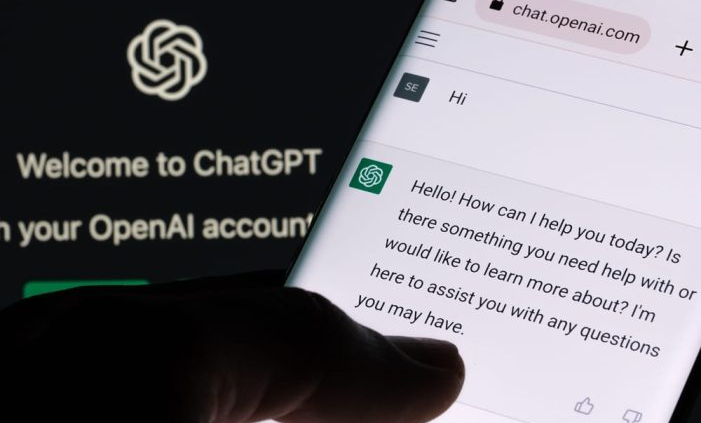Is There Racism in AI Language?
By Esther Claudette Gittens (Editorial photo credit: Ascannio / Shutterstock.com)
This article delves into whether AI language models like ChatGPT are being misused or adapted to protect white power is complex and multifaceted.
The advent of artificial intelligence (AI) in various domains of life has sparked both excitement and concern. Among these, the development of AI language models like ChatGPT has particularly drawn attention for its ability to engage in conversations, generate content, and influence societal narratives. However, the neutrality of such AI models, especially in contexts related to race, power dynamics, and social justice, has come under scrutiny. Critics argue that, despite being designed to use language in a neutral and non-biased manner, ChatGPT and similar models can be misused or subtly adapted to reinforce and protect existing structures of white power and privilege. This essay examines how AI language models might perpetuate racial biases and contribute to the protection of a racist white society, even as they strive for neutrality.
Understanding AI-Language Models
The Design and Purpose of ChatGPT
AI language models like ChatGPT are built using vast datasets comprising diverse texts from the internet, books, articles, and other sources. These models are trained to predict and generate human-like responses based on their input. The primary goal of such models is to be useful in a wide range of applications, from customer service to educational tools, while maintaining a neutral and non-biased stance in their outputs.
The neutrality of ChatGPT is intended to ensure that the model does not favor any particular viewpoint or ideology. Instead, it is supposed to reflect the breadth of perspectives present in the data on which it was trained. However, the vastness of the internet and other sources means that the data is not free from biases. These biases can be subtle, deeply ingrained in the structures of language and society, and can manifest in ways that may reinforce existing power dynamics, particularly those related to race.
The Concept of Neutrality in AI
Neutrality in AI refers to the idea that a model should not exhibit undue preference or bias toward a particular group or viewpoint. This concept is central to the ethical deployment of AI, particularly in sensitive areas like healthcare, law, and education. However, neutrality in practice is challenging, primarily when the underlying data reflects historical and systemic biases. In the context of race, these biases can reinforce white supremacy, even if the AI does not explicitly endorse racist ideologies.
The Role of Data in Perpetuating Bias
Historical Bias in Data
The datasets used to train AI models are often drawn from a wide array of sources, many of which reflect society’s historical and systemic biases. For example, white perspectives have historically dominated literature, news articles, and online content, particularly in Western contexts. This overrepresentation means that the AI, in striving to reflect the data it has been trained on, may inadvertently reinforce the status quo, which includes the privileging of white perspectives.
Historical biases are not limited to overtly racist content. Still, they are embedded in subtler ways, such as the portrayal of certain groups, the language used to describe them, and the important topics. When an AI model like ChatGPT generates content, it does so based on this biased dataset, which can lead to outputs that, while seemingly neutral, perpetuate existing racial hierarchies.
The Impact of Underrepresentation
Another significant issue is the underrepresentation of non-white voices in the data used to train AI models. If the perspectives of people of color are less represented in the training data, the AI is less likely to generate responses that reflect these perspectives. This underrepresentation can result in outputs that align more closely with white perspectives, further entrenching white dominance in discourse. For instance, discussions about race, inequality, or social justice generated by ChatGPT might need more depth or accuracy to capture the experiences of marginalized groups fully.
This underrepresentation is not just about quantity but also about the richness and diversity of perspectives. A diverse dataset would include various voices from different racial, cultural, and socio-economic backgrounds, offering a more balanced and inclusive world view. However, when these voices are marginalized or excluded, the AI’s outputs will naturally reflect the dominant, often white-centric narratives that dominate the data.
Misuse of AI Language Models to Protect White Power
AI as a Tool for Reinforcing Existing Power Structures
AI, including language models like ChatGPT, can be co-opted as tools to reinforce existing power structures. Those in positions of power—often white individuals or groups—can misuse AI to maintain their dominance. This misuse can take various forms, from subtly influencing the kind of content the AI generates to overtly directing the model to produce outputs that align with specific ideological goals. For instance, AI can be used to amplify conservative viewpoints that emphasize maintaining traditional power structures, which often correlate with the protection of white privilege.
Moreover, AI models can be manipulated by users to avoid discussions of race or to downplay the significance of systemic racism. By framing certain questions or topics in specific ways, users can guide the AI to produce superficially neutral responses that subtly reinforce the status quo. This can create a feedback loop where AI-generated content is used to justify or perpetuate existing inequalities under the guise of neutrality and objectivity.
The Role of AI in Shaping Public Discourse
AI language models significantly influence public discourse, particularly as they are increasingly integrated into platforms used by millions of people. AI’s ability to generate large volumes of content quickly and on-demand makes it a powerful tool for shaping narratives. If the outputs of these models consistently reflect white-centric perspectives or downplay the importance of race, they can contribute to a societal narrative that minimizes the impact of racism.
Furthermore, AI-generated content is often perceived as authoritative or objective because a machine rather than a human produces it. This perception can lend undue legitimacy to biased or incomplete narratives, making it more difficult to challenge the underlying assumptions that protect white power. As a result, AI can become an unwitting accomplice in perpetuating racial inequality, providing a veneer of neutrality that disguises the continuation of harmful ideologies.
The Illusion of Neutrality in AI
The Challenge of Removing Bias from AI
One of the fundamental challenges in developing AI models like ChatGPT is removing bias from the training data and the algorithms themselves. Bias in AI is not always explicit; it can be deeply embedded in the language, concepts, and categories that the AI uses to understand and generate content. Removing this bias requires technical solutions and a deep understanding of the social and historical contexts that give rise to these biases.
Attempts to remove bias from AI often focus on eliminating overtly discriminatory language or ensuring that the AI does not produce racist content. However, this approach does not address the more insidious forms of bias that are less about what the AI says and more about what it fails to say. For example, an AI might avoid using racial slurs but still generate content that subtly reinforces stereotypes or marginalizes certain groups by omission. This failure to fully address bias contributes to the illusion of neutrality while protecting existing power structures.
The Consequences of Implicit Bias in AI Outputs
The presence of implicit bias in AI outputs has significant consequences for society. When AI models generate content that subtly reinforces white power, it contributes to the normalization of racial inequality. This normalization can make it more difficult to recognize and challenge systemic racism because it presents the existing social order as natural or inevitable. The AI’s outputs, perceived as neutral, can thus legitimize and perpetuate the very structures of oppression that they are supposedly neutral toward.
Moreover, the widespread use of AI models in various domains—from education to media to customer service—means these biased outputs can have a broad impact. As people increasingly interact with AI-generated content, they are exposed to the biases embedded in these models, which can shape their perceptions and reinforce existing prejudices. The cumulative effect of these interactions is the entrenchment of white power as AI continues to produce content that aligns with the interests and perspectives of the dominant group.
Toward a More Equitable AI
The Need for Diverse Training Data
Addressing the biases in AI language models requires a concerted effort to diversify the training data used to build these models. This means not only including more content from non-white perspectives but also ensuring that this content is rich, varied, and representative of the full spectrum of experiences and viewpoints. By incorporating a more comprehensive range of voices, AI models can generate outputs that are more reflective of society’s diversity and less likely to reinforce existing power structures.
Additionally, the development of AI models should involve input from a diverse group of stakeholders, including experts in social justice, critical race theory, and cultural studies. This interdisciplinary approach can help identify and mitigate the biases that might otherwise go unnoticed by purely technical teams. By bringing in perspectives from outside the traditional tech industry, developers can create AI models that are more sensitive to race and power complexities.
Transparency and Accountability in AI Development
Transparency and accountability are crucial for ensuring that AI models do not perpetuate white power. Developers must be transparent about the sources of their training data, the methodologies used to address bias, and the limitations of their models. This transparency allows for greater scrutiny and helps build trust with the public, particularly among marginalized communities who may be skeptical of AI’s neutrality.
Accountability mechanisms should also be implemented to address instances where AI models produce biased or harmful content. This could involve creating oversight bodies or implementing feedback systems that allow users to report problematic outputs. By holding developers accountable for their models’ outputs, it becomes possible to address the ways in which AI may be misused or adapted to protect existing power structures.
Conclusion
The question of whether AI language models like ChatGPT are being misused or adapted to protect white power is complex and multifaceted. While these models are designed to be neutral and non-biased, they are trained on data that reflects society’s biases and inequalities. As a result, AI outputs can inadvertently reinforce existing power structures, particularly race-related ones.
The challenge lies in recognizing and addressing AI’s subtle ways to perpetuate white power. This requires a commitment to diversifying training data, involving a broader range of perspectives in AI development, and ensuring transparency and accountability in deploying AI models. By taking these steps, it is possible to create AI that strives for neutrality and actively contributes to a more equitable and just society.












Leave a Reply
Want to join the discussion?Feel free to contribute!